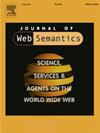Integrating Knowledge Graphs with Symbolic AI: The Path to Interpretable Hybrid AI Systems in Medicine
IF 3.1
3区 计算机科学
Q3 COMPUTER SCIENCE, ARTIFICIAL INTELLIGENCE
引用次数: 0
Abstract
Knowledge Graphs (KGs) are graph-based structures that integrate heterogeneous data, capture domain knowledge, and enable explainable AI through symbolic reasoning. This position paper examines the challenges and research opportunities in integrating KGs with neuro-symbolic AI, highlighting their potential to enhance explainability, scalability, and context-aware reasoning in hybrid AI systems. Using a lung cancer use case, we illustrate how hybrid approaches address tasks such as link prediction—uncovering hidden relationships in medical data—and counterfactual reasoning—analyzing alternative scenarios to understand causal factors. The discussion is framed around TrustKG, which demonstrates how constraint validation, causal reasoning, and user-centric communication can support transparent and reliable decision-making. Additionally, we identify current limitations of KGs, including gaps in knowledge coverage, evolving data integration challenges, and the need for improved usability and impact assessment. These insights are not limited to healthcare but extend to other domains like energy, manufacturing, and mobility, showcasing the broad applicability of KGs. Finally, we propose research directions to unlock their full potential in building robust, transparent, and widely adopted real-world applications.

集成知识图与符号人工智能:医学中可解释的混合人工智能系统之路
知识图(KGs)是基于图的结构,它集成了异构数据,捕获领域知识,并通过符号推理实现可解释的人工智能。本文探讨了将KGs与神经符号人工智能集成的挑战和研究机遇,强调了它们在混合人工智能系统中增强可解释性、可扩展性和上下文感知推理的潜力。通过肺癌用例,我们说明了混合方法如何处理链接预测(揭示医疗数据中的隐藏关系)和反事实推理(分析替代方案以了解因果因素)等任务。讨论围绕TrustKG展开,它演示了约束验证、因果推理和以用户为中心的通信如何支持透明和可靠的决策。此外,我们还确定了当前知识库的局限性,包括知识覆盖方面的差距、不断发展的数据集成挑战,以及改进可用性和影响评估的需求。这些见解不仅局限于医疗保健领域,还扩展到能源、制造和移动等其他领域,展示了kg的广泛适用性。最后,我们提出了研究方向,以充分发挥其在构建强大、透明和广泛采用的现实应用中的潜力。
本文章由计算机程序翻译,如有差异,请以英文原文为准。
求助全文
约1分钟内获得全文
求助全文
来源期刊

Journal of Web Semantics
工程技术-计算机:人工智能
CiteScore
6.20
自引率
12.00%
发文量
22
审稿时长
14.6 weeks
期刊介绍:
The Journal of Web Semantics is an interdisciplinary journal based on research and applications of various subject areas that contribute to the development of a knowledge-intensive and intelligent service Web. These areas include: knowledge technologies, ontology, agents, databases and the semantic grid, obviously disciplines like information retrieval, language technology, human-computer interaction and knowledge discovery are of major relevance as well. All aspects of the Semantic Web development are covered. The publication of large-scale experiments and their analysis is also encouraged to clearly illustrate scenarios and methods that introduce semantics into existing Web interfaces, contents and services. The journal emphasizes the publication of papers that combine theories, methods and experiments from different subject areas in order to deliver innovative semantic methods and applications.
 求助内容:
求助内容: 应助结果提醒方式:
应助结果提醒方式:


